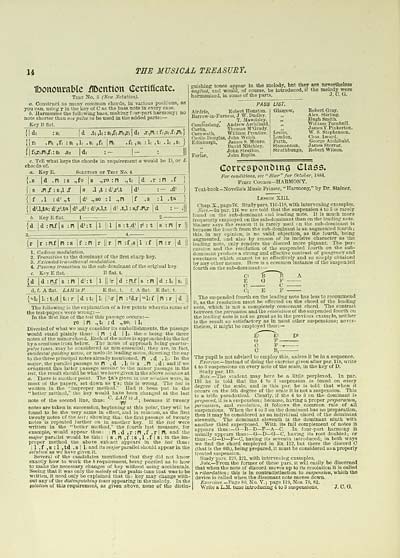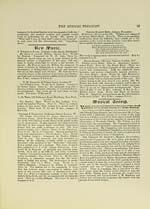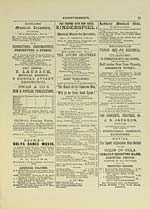Glen Collection of printed music > Printed music > Köhlers’ violin repository of dance music > Volume 1
(116) Page 14
Download files
Complete book:
Individual page:
Thumbnail gallery: Grid view | List view

14
TEE MUSICAL TREASURY.
Bonoutable /Mention Certificate.
Test No. 5 (New Notation).
a. Construct as many common chords, in various positions, as
you can, using r in the key of as the bass note in every case.
h. Harmonise the following bass, mal;ingf.ur-part harmony; no
note shorter than one puUeioXiQ used in the added parts : —
Key B flat.
{ di :si d .ti,li:si/i.ni^i|di .ri,nii:fi,S|Xi,Wi}
{ n .Hi ,fi :sr ,li .S| ,fi Hi .fi ,si : li ,ti .li ,si }
{|fiAni/i:si .S2 |di :- |- : ||
c. Tell what keys the chorda in requirement a would be D, or L
chords of.
a. Key E. SoinTioN of Test No. 4.
{.s |d .n :s .,fe s .,re;n .,t| d .r -.n .f }
{|s .n^:s,li |s .l,t :dip:i.t |di :- .d' }
{jf .1 :di .,t di .,se :1 .,I<1 |f .s :1 .ta }
{ 1 di.l,ta: di,ri.ta di .,di : di,s.l,t di .t,l : s^ .Pipe | d : - .||
{d |d:Pl.f s :n |di:t |l || 1 3:tjil ri : t |s : PI |r |
3. 4.
{r |r :mi|n :b |f :n |r ||r n :f^|l ;f jn :r d |
1. Cadence modulation.
2. Transition to the dorninant of the first sharp key.
3. Extended tra-isitional modulation.
4. Passing transition to the sub-dominant of the original key.
c. Kev E flat B flat. t.
{1
d : af s : n 1 d'
t |1 ll>r|d
:Pli|s :Pl d :li si |{
d.
f. Aflat. LA/IisF.
E flat, t.
t. A flat. E flat. t.
{..1
i|li:M|ti:r |d
ti |li ||i.r |n
:«dj|'"l:f \n :r |d 1|
guishiug tones appear in the melody, but tkey are neverthelesa
implied, and woukl. of course, be introduced, if the melody were
harmonised, in some of the parts.
J. C. G.
PASS LIST.
Airdrie, Robert Houston.
Barrow-in-Fiu-ness. J "W. Dudley.
„ T. Wawdsley.
Cambuslang, Andrew Archibald
Carfin, Thomas M'Grady.
Carnwath, William Prentice.
Castle Douglas, John Welsh.
Ediuburgb, James S. Monro.
„ David Mltchley.
John Strathie.
Forfar, John Esplin.
Glasgow,
Leslie,
London,
Perth,
Slamannan,
Strathbuugo,
Robert Gray.
Alex. Stirling.
Hugh Smith.
William Tunibull.
James Y.Piukerton.
W. S. Stephenson.
Chas. Iseard.
George Archibald.
James Storrar.
Robert Wilson.
The following is the explanation of a few points wherein some of
tho test-papers were wrong: —
In tho first lino of the test this passage occurs:—
re I n .,ti : d .,sei 1 1|
Divested of what wo may consider its embellishments, the passage
would stand plainly thus: | PI : d I li. the-e being tho three
notes of the minor chord. Each of ihe notes is approached in the test
by a semitone from below. The notes of approach being quarier-
^u?se iones, may be considered as non-essential; they are, in fact,
incidental guiding notes, or nielo lic leading notes, directing the ear
to the three principal notes already mentioned, Pl . d . 1|. In the
major, the parallel passage to PI . d . 1| is s .PI . d ; and if we
ornament this latter i^assage similar to the minor passage in the
test, the result should be what we have given in the above solution at
a. There is another point. The ta-'s given in our solution were, in
most of the papers, set down as t's; this is wrong. The test is
written in the "improper method." Had it bean put in the
''better method," the key would have been changed at the last
note of the second line, thus: ' i_| ^^'^; because if twenty
notes are taken in succession, beginning at this poinf, they will be
found to be the very same in effect, and in relation, as the first
twenty notes ot tho test; showing that the first passage of twenty
notes is repeated further on in another key. If the test were
written in the "better methoJ," the fourth last measure, for
example, would appear thus: |Pl.djr:n,f.r[Pl, and the
major pariiilel would be this: | s .H ,f :s ,1 .f I S; in the im-
proper method the above exti act appears in the test thus :
|l,f,S:l,td.3| 1, and its mo^o/' parallel should appear in the
solution as we have given it.
Several of the candidates mentioned that they did not know
exactly how to work the b requirement, being puzzled as to how
to make the necessary changes of key without using accidentals.
Seeing that it was only the melody of the paalm-tune toat was to be
written, it need only be explained that th'.^ key may change with-
out any of the distinguishing tones appearing in the melody. In the
solution of this requirement, as given above, none of the distiu-
Cotrespon&tng Class,
For conditions, see ''Star" for October, 1884.
First Course— HARMONY.
Text-book— Novello's Music Primer, " Harmony," by Dr. Stainer.
Lesson XIII.
Chap. X., page 7G. Study pars. 116-118, with intervening examples.
iYoi'e.— In par. IIG we are told that the suspension 4 to 3 is rarely
fouud on the sub-dominant and leading note. It is much more
frequently employed on the sub-dominant than on the leading note.
Stainer says the reason it is rarely used on the sub-dominant is
because the fourth from the sub-dominant is an augmented fourth;
this, in my opinion, is no valid objection, as the fourth, being
augmented, und also by reason of its incisive character as the
leading note, only renders the discord more piquant. The per-
cussion and the resolution of the suspended fourth on the sub-
dominant produce a sti'ong and effective contrast of pungency and
sweetness which cannot be so effectively and so simply obtained
by any other means. Here is a common instance of the suspended
fourth on the sub-dominant: —
CI ^ ^ A
E a F
G C
C, E F
Tho suspended fourth on the leading note has less to recommend
it, as the resolution must be effected on the chord of tho leading
note, which is not a completely consonant chord. The contrast
between the percussion and the resolution of the suspended fourth on
the leading note is not so great as in the previous example, neither
is the result so satisfactory as in most other suspensions; never-
theless, it might be employed thus:—
O
C
El
F-
F-
B,-
Dl
The pupil is not advised to employ this, unless it be in a sequence.
Exercise. — Instead of doing the exercise given after par. 118, write
4 to 3 suspensions on every note of tho scale, in the key of D.
Study par. 119.
^o^e.__The student may here be a little perplexed. In par.
116 he is told that the 4 to 3 suspension is found on every
degree of the scale, and in this par. he is told that when it
occurs on the 5th degree of the scale it is not a suspension. This
is a trifle paradoxical. Clearly, if the 4 to 3 on the dominant is
prepared, it is a suspension; because, having a proper preparation,
percussion, and resolution, it follows the common rule of all
suspensions. "When the 4 to 3 on the dominant has no preparation,
then it may be considered as an individual chord of the dominant
elevenllL The dominaiit eleventh is the dominant ninth with
another third superposed. With its full complement of notes it
appears thus:— 6— B— D— F— A— C. In four-part harmony it
usually appears thus: — G — D— G— C, having its root doubled; or
thus:— G— D— F— 0, having its seventh introduced; in both ways
we find the chord employed in Ex. 112, but there the discord C
(that is the 4th), being prepared, it must be considered as a properly
treated suspension.
Study pars. 1*20, 121, with intervening examples.
A'ote, — From the former of these pars, it will easily be discerned
that when the note of discord moves up to its resolution it is called
a. 7'iiardation : this is in contradistinction to suspension, "which the
device is called when the dissonant note moves down.
Exercises. —Vaso 80, No. V.; page 119, Nos. 70, 82.
Write a L.M, tune introducing 4 to 3 suspensions. J. 0. G,
TEE MUSICAL TREASURY.
Bonoutable /Mention Certificate.
Test No. 5 (New Notation).
a. Construct as many common chords, in various positions, as
you can, using r in the key of as the bass note in every case.
h. Harmonise the following bass, mal;ingf.ur-part harmony; no
note shorter than one puUeioXiQ used in the added parts : —
Key B flat.
{ di :si d .ti,li:si/i.ni^i|di .ri,nii:fi,S|Xi,Wi}
{ n .Hi ,fi :sr ,li .S| ,fi Hi .fi ,si : li ,ti .li ,si }
{|fiAni/i:si .S2 |di :- |- : ||
c. Tell what keys the chorda in requirement a would be D, or L
chords of.
a. Key E. SoinTioN of Test No. 4.
{.s |d .n :s .,fe s .,re;n .,t| d .r -.n .f }
{|s .n^:s,li |s .l,t :dip:i.t |di :- .d' }
{jf .1 :di .,t di .,se :1 .,I<1 |f .s :1 .ta }
{ 1 di.l,ta: di,ri.ta di .,di : di,s.l,t di .t,l : s^ .Pipe | d : - .||
{d |d:Pl.f s :n |di:t |l || 1 3:tjil ri : t |s : PI |r |
3. 4.
{r |r :mi|n :b |f :n |r ||r n :f^|l ;f jn :r d |
1. Cadence modulation.
2. Transition to the dorninant of the first sharp key.
3. Extended tra-isitional modulation.
4. Passing transition to the sub-dominant of the original key.
c. Kev E flat B flat. t.
{1
d : af s : n 1 d'
t |1 ll>r|d
:Pli|s :Pl d :li si |{
d.
f. Aflat. LA/IisF.
E flat, t.
t. A flat. E flat. t.
{..1
i|li:M|ti:r |d
ti |li ||i.r |n
:«dj|'"l:f \n :r |d 1|
guishiug tones appear in the melody, but tkey are neverthelesa
implied, and woukl. of course, be introduced, if the melody were
harmonised, in some of the parts.
J. C. G.
PASS LIST.
Airdrie, Robert Houston.
Barrow-in-Fiu-ness. J "W. Dudley.
„ T. Wawdsley.
Cambuslang, Andrew Archibald
Carfin, Thomas M'Grady.
Carnwath, William Prentice.
Castle Douglas, John Welsh.
Ediuburgb, James S. Monro.
„ David Mltchley.
John Strathie.
Forfar, John Esplin.
Glasgow,
Leslie,
London,
Perth,
Slamannan,
Strathbuugo,
Robert Gray.
Alex. Stirling.
Hugh Smith.
William Tunibull.
James Y.Piukerton.
W. S. Stephenson.
Chas. Iseard.
George Archibald.
James Storrar.
Robert Wilson.
The following is the explanation of a few points wherein some of
tho test-papers were wrong: —
In tho first lino of the test this passage occurs:—
re I n .,ti : d .,sei 1 1|
Divested of what wo may consider its embellishments, the passage
would stand plainly thus: | PI : d I li. the-e being tho three
notes of the minor chord. Each of ihe notes is approached in the test
by a semitone from below. The notes of approach being quarier-
^u?se iones, may be considered as non-essential; they are, in fact,
incidental guiding notes, or nielo lic leading notes, directing the ear
to the three principal notes already mentioned, Pl . d . 1|. In the
major, the parallel passage to PI . d . 1| is s .PI . d ; and if we
ornament this latter i^assage similar to the minor passage in the
test, the result should be what we have given in the above solution at
a. There is another point. The ta-'s given in our solution were, in
most of the papers, set down as t's; this is wrong. The test is
written in the "improper method." Had it bean put in the
''better method," the key would have been changed at the last
note of the second line, thus: ' i_| ^^'^; because if twenty
notes are taken in succession, beginning at this poinf, they will be
found to be the very same in effect, and in relation, as the first
twenty notes ot tho test; showing that the first passage of twenty
notes is repeated further on in another key. If the test were
written in the "better methoJ," the fourth last measure, for
example, would appear thus: |Pl.djr:n,f.r[Pl, and the
major pariiilel would be this: | s .H ,f :s ,1 .f I S; in the im-
proper method the above exti act appears in the test thus :
|l,f,S:l,td.3| 1, and its mo^o/' parallel should appear in the
solution as we have given it.
Several of the candidates mentioned that they did not know
exactly how to work the b requirement, being puzzled as to how
to make the necessary changes of key without using accidentals.
Seeing that it was only the melody of the paalm-tune toat was to be
written, it need only be explained that th'.^ key may change with-
out any of the distinguishing tones appearing in the melody. In the
solution of this requirement, as given above, none of the distiu-
Cotrespon&tng Class,
For conditions, see ''Star" for October, 1884.
First Course— HARMONY.
Text-book— Novello's Music Primer, " Harmony," by Dr. Stainer.
Lesson XIII.
Chap. X., page 7G. Study pars. 116-118, with intervening examples.
iYoi'e.— In par. IIG we are told that the suspension 4 to 3 is rarely
fouud on the sub-dominant and leading note. It is much more
frequently employed on the sub-dominant than on the leading note.
Stainer says the reason it is rarely used on the sub-dominant is
because the fourth from the sub-dominant is an augmented fourth;
this, in my opinion, is no valid objection, as the fourth, being
augmented, und also by reason of its incisive character as the
leading note, only renders the discord more piquant. The per-
cussion and the resolution of the suspended fourth on the sub-
dominant produce a sti'ong and effective contrast of pungency and
sweetness which cannot be so effectively and so simply obtained
by any other means. Here is a common instance of the suspended
fourth on the sub-dominant: —
CI ^ ^ A
E a F
G C
C, E F
Tho suspended fourth on the leading note has less to recommend
it, as the resolution must be effected on the chord of tho leading
note, which is not a completely consonant chord. The contrast
between the percussion and the resolution of the suspended fourth on
the leading note is not so great as in the previous example, neither
is the result so satisfactory as in most other suspensions; never-
theless, it might be employed thus:—
O
C
El
F-
F-
B,-
Dl
The pupil is not advised to employ this, unless it be in a sequence.
Exercise. — Instead of doing the exercise given after par. 118, write
4 to 3 suspensions on every note of tho scale, in the key of D.
Study par. 119.
^o^e.__The student may here be a little perplexed. In par.
116 he is told that the 4 to 3 suspension is found on every
degree of the scale, and in this par. he is told that when it
occurs on the 5th degree of the scale it is not a suspension. This
is a trifle paradoxical. Clearly, if the 4 to 3 on the dominant is
prepared, it is a suspension; because, having a proper preparation,
percussion, and resolution, it follows the common rule of all
suspensions. "When the 4 to 3 on the dominant has no preparation,
then it may be considered as an individual chord of the dominant
elevenllL The dominaiit eleventh is the dominant ninth with
another third superposed. With its full complement of notes it
appears thus:— 6— B— D— F— A— C. In four-part harmony it
usually appears thus: — G — D— G— C, having its root doubled; or
thus:— G— D— F— 0, having its seventh introduced; in both ways
we find the chord employed in Ex. 112, but there the discord C
(that is the 4th), being prepared, it must be considered as a properly
treated suspension.
Study pars. 1*20, 121, with intervening examples.
A'ote, — From the former of these pars, it will easily be discerned
that when the note of discord moves up to its resolution it is called
a. 7'iiardation : this is in contradistinction to suspension, "which the
device is called when the dissonant note moves down.
Exercises. —Vaso 80, No. V.; page 119, Nos. 70, 82.
Write a L.M, tune introducing 4 to 3 suspensions. J. 0. G,
Set display mode to: Large image | Transcription
Images and transcriptions on this page, including medium image downloads, may be used under the Creative Commons Attribution 4.0 International Licence unless otherwise stated. ![]()
| Special collections of printed music > Glen Collection of printed music > Printed music > Köhlers’ violin repository of dance music > Volume 1 > (116) Page 14 |
|---|
| Permanent URL | https://digital.nls.uk/91451448 |
|---|
| Shelfmark | Glen.224 |
|---|---|
| Additional NLS resources: | |
| Attribution and copyright: |
|
| Description | Scottish songs and music of the 18th and early 19th centuries, including music for the Highland bagpipe. These are selected items from the collection of John Glen (1833 to 1904). Also includes a few manuscripts, some treatises, and other books on the subject. |
|---|
| Description | The Glen Collection and the Inglis Collection represent mainly 18th and 19th century Scottish music, including Scottish songs. The collections of Berlioz and Verdi collected by bibliographer Cecil Hopkinson contain contemporary and later editions of the works of the two composers Berlioz and Verdi. |
|---|

